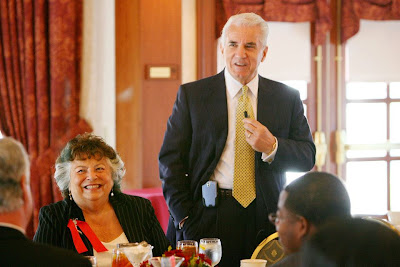Welcome to my Blog!
Allow me to introduce myself. My name is Angelo Armenti, Jr., and the name
of my blog is ‘Thoughts on the Future of
Higher Education.’
I believe that access to higher education represents a
critical opportunity for today’s youth.
It was an opportunity that I was fortunate to receive, and an
opportunity that I believe we must all work together to preserve so that,
despite many grave challenges, it will continue to be there for future students.Specifically, I believe that anyone who has been fortunate enough to receive a college education in the past has an obligation to help preserve that opportunity for others in the future, and that’s the reason why I have decided to launch this blog.
If helping to preserve access to higher education for
tomorrow’s students should appeal to you, I encourage you become a part of this
blog, and to invite your friends to become a part of it as well.
The ‘higher education’ I will focus on is one familiar to most
who attended a college or university after graduation from high school for the
purpose of obtaining a degree. The
institutions that provide such higher education come in two broad categories: private
and public and, as it happens, I have
had considerable experience over the past 42 years working in each of those two
higher education sectors.
From 1972 to 1992, I was a physics professor, department
chair, dean of University College, and director of planning at Villanova
University, a private university located
in the western suburbs of Philadelphia.
From 1992 to 2012, I was president of California University
of Pennsylvania (Cal U), a “state-owned” public
university, and one of the fourteen (14) public
universities—and former normal schools/state teachers’ colleges—in the
Pennsylvania State System of Higher Education (PASSHE).
And from 1970 to 1972, I was an assistant professor of
physics at Temple University in Philadelphia, one of Pennsylvania’s four, “state-related”
universities; the other three include Penn State, Pitt and Lincoln.
“Public
Universities”
In Pennsylvania, both the “state-owned” and “state-related”
universities are thought to be, and are often said to be, public universities. That
statement, although somewhat true, is also misleading.
The “state-related”
universities in Pennsylvania are both ‘quasi-private’ and ‘quasi-public.’ That is, they receive some state funding (something less
than one-fifth of their annual operating revenue), while retaining most
of the independence, and many of the prerogatives, enjoyed by private universities.
The “state-owned” (PASSHE) universities in Pennsylvania are
also ‘quasi private’ and ‘quasi-public.’
They receive some state funding (something more than one-fifth of their annual operating revenue),
while enjoying little of the independence, and none of the prerogatives of state-related or private universities.
State-Related
Universities
Although the state only provides a small fraction of the total
annual operating budgets of the state-related
universities, the actual dollar amounts can be quite large, as shown in the
table below, which is taken from the final approved Pennsylvania Budget for FY
2012-13.
For 2012-13, the Commonwealth Budget will provide: $228 million to Penn State; $134 million to
Pitt; $140 million to Temple; $11.2 million to Lincoln.
The Commonwealth Budget for 2012-13 also provides $413
million to the 14-university PASSHE system.
A fair comparison regarding the relative funding levels to Pennsylvania’s
various ‘public’ universities (whether ‘state-related’ or ‘state-owned’),
requires looking not at the total appropriation
dollars each receives, but rather at the number of appropriation dollars per full-time-equivalent
(FTE) student at each institution. When
the FTE enrollments at the various ‘public’ universities are factored in, the
appropriation per FTE student comes to about $4,500/FTE student at each of those
universities in 2012.
Back in 1987, however, the State appropriation/FTE student
(measured in 2012 dollars) was $9,167.
That is, in terms of actual purchasing
power, the 2012 figure is 51% lower than it was in 1987, meaning that for every State dollar available to
educate a student 25 years ago, only 49 cents is available today.


No comments:
Post a Comment